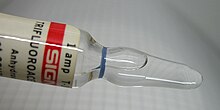
Back تریفلورواستیک اسید AZB Трифлуороцетна киселина Bulgarian Àcid trifluoroacètic Catalan Kyselina trifluoroctová Czech Trifluoressigsäure German Τριφθοραιθανικό οξύ Greek Trifluoroacetata acido Esperanto Ácido trifluoroacético Spanish تریفلورواستیک اسید Persian Trifluorietikkahappo Finnish
| |||

| |||

| |||
| Names | |||
|---|---|---|---|
| Preferred IUPAC name
Trifluoroacetic acid | |||
| Other names
2,2,2-Trifluoroacetic acid
2,2,2-Trifluoroethanoic acid Perfluoroacetic acid Trifluoroethanoic acid TFA | |||
| Identifiers | |||
3D model (JSmol)
|
|||
| 742035 | |||
| ChEBI | |||
| ChEMBL | |||
| ChemSpider | |||
| ECHA InfoCard | 100.000.846 | ||
| 2729 | |||
PubChem CID
|
|||
| RTECS number |
| ||
| UNII | |||
CompTox Dashboard (EPA)
|
|||
| |||
| |||
| Properties | |||
| C2HF3O2 | |||
| Molar mass | 114.023 g·mol−1 | ||
| Appearance | colorless liquid | ||
| Odor | Pungent/Vinegar | ||
| Density | 1.489 g/cm3, 20 °C | ||
| Melting point | −15.4 °C (4.3 °F; 257.8 K) | ||
| Boiling point | 72.4 °C (162.3 °F; 345.5 K) | ||
| miscible | |||
| Vapor pressure | 0.0117 bar (1.17 kPa) at 20 °C[1] | ||
| Acidity (pKa) | 0.52 [2] | ||
| Conjugate base | trifluoroacetate | ||
| -43.3·10−6 cm3/mol | |||
| Hazards | |||
| Occupational safety and health (OHS/OSH): | |||
Main hazards
|
Highly corrosive | ||
| GHS labelling: | |||
 
| |||
| Danger | |||
| H314, H332, H412 | |||
| P260, P261, P264, P271, P273, P280, P301+P330+P331, P303+P361+P353, P304+P312, P304+P340, P305+P351+P338, P310, P312, P321, P363, P405, P501 | |||
| NFPA 704 (fire diamond) | |||
| Safety data sheet (SDS) | External MSDS | ||
| Related compounds | |||
Related perfluorinated acids
|
Heptafluorobutyric acid Perfluorooctanoic acid Perfluorononanoic acid | ||
Related compounds
|
Acetic acid Trichloroacetic acid | ||
Except where otherwise noted, data are given for materials in their standard state (at 25 °C [77 °F], 100 kPa).
| |||
Trifluoroacetic acid (TFA) is a synthetic organofluorine compound with the chemical formula CF3CO2H. It is a haloacetic acid, with all three of the acetyl group's hydrogen atoms replaced by fluorine atoms. It is a colorless liquid with a vinegar-like odor. TFA is a stronger acid than acetic acid, having an acid ionisation constant, Ka, that is approximately 34,000 times higher,[3] as the highly electronegative fluorine atoms and consequent electron-withdrawing nature of the trifluoromethyl group weakens the oxygen-hydrogen bond (allowing for greater acidity) and stabilises the anionic conjugate base. TFA is commonly used in organic chemistry for various purposes.
- ^ Kreglewski, A. (1962). "Trifluoroacetic acid". Welcome to the NIST WebBook. 10 (11–12): 629–633. Retrieved 1 March 2020.
- ^ W. M. Haynes.; David R. Lide; Thomas J. Bruno, eds. (2016–2017). CRC Handbook of Chemistry and Physics. CRC Press. pp. 954–963. ISBN 978-1-4987-5429-3.
- ^ Note: Calculated from the ratio of the Ka values for TFA (pKa = 0.23) and acetic acid (pKa = 4.76)


